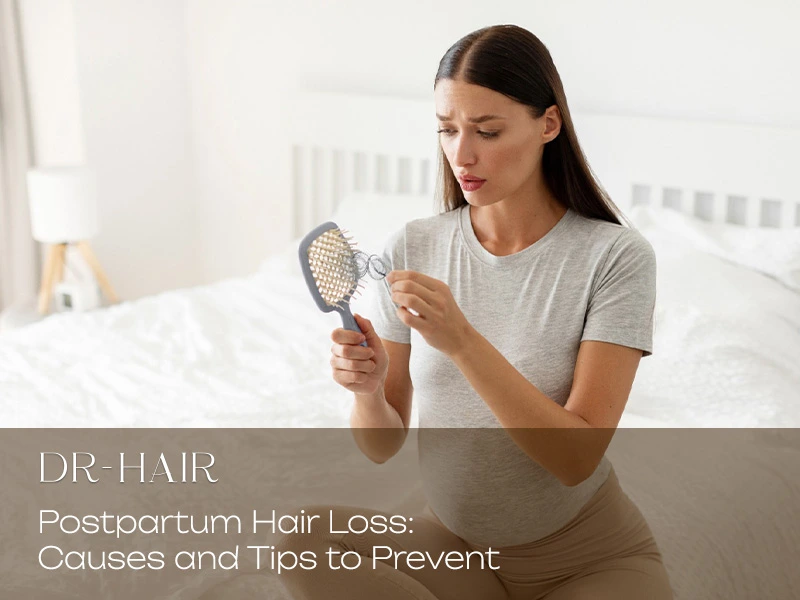Postpartum Hair Loss
Welcoming a new baby is a beautiful, life-changing experience—but it also comes with many physical changes for the mother. One common issue that catches many new moms off guard is postpartum hair loss. If you’re running your fingers through your hair and finding clumps falling out months after childbirth, you’re not alone.
Let’s dive into why this happens, how to manage it, and answer some of the most common questions moms have.
Why Does Postpartum Hair Loss Happen?
It’s All About Hormones
During pregnancy, your body is flooded with high levels of estrogen, which causes your hair to stay in the growth phase (anagen phase) longer. That’s why many women report thicker, shinier hair during pregnancy.
But after childbirth, estrogen levels drop suddenly, and your hair enters the resting phase (telogen phase), causing a large amount of hair to shed all at once—usually around 2 to 4 months postpartum.
This condition is known as telogen effluvium, and while it can feel alarming, it’s completely normal and temporary.
How Long Does Postpartum Hair Loss Last?
Most women experience noticeable shedding for a few months, but it typically slows down by 6 months postpartum and resolves completely by 12 months. However, factors like stress, lack of sleep, or underlying nutritional deficiencies can prolong recovery.
How to Fix or Minimize Postpartum Hair Loss
While you can’t stop it entirely, there are several things you can do to minimize shedding and support healthy hair regrowth.
1. Maintain a Healthy Diet
Postpartum recovery requires a nutrient-rich diet. Focus on:
Protein (essential for hair structure)
Iron (low levels can trigger hair loss)
Vitamin D and B-complex vitamins, especially Biotin
Zinc and Omega-3 fatty acids
2. Be Gentle With Your Hair
Avoid tight ponytails or buns
Skip heat styling tools like straighteners and curlers
Use wide-tooth combs to reduce breakage
Avoid harsh chemical treatments
3. Try Hair Growth Products
There are various shampoos, serums, and supplements specifically designed for postpartum hair regrowth. Look for:
Biotin
Keratin
Castor Oil
Caffeine-based shampoos
4. Consider PRP (Platelet-Rich Plasma) Therapy
This treatment involves using your own blood platelets to stimulate hair follicles. It’s safe, minimally invasive, and has shown promising results in postpartum hair recovery.
5. Supplements
If you’re not getting enough nutrients from your diet alone, talk to your doctor about postpartum-safe supplements.
Popular hair supplements in Malaysia:
Nutrifactor Biotin Plus (RM 40–RM 60/month)
Shaklee Zinc Complex (RM 40–RM 70/month)
Viviscal or SugarBear Hair (Imported, RM 120–RM 250/month)
Frequently Asked Questions
1. Is postpartum hair loss permanent?
No, it’s usually temporary. Most women see their hair return to normal within 6–12 months after birth.
2. How much hair loss is normal postpartum?
It’s normal to lose up to 300 hairs per day during postpartum shedding, compared to the usual 50–100 strands.
3. Can breastfeeding cause hair loss?
Breastfeeding itself doesn’t cause hair loss, but the hormonal fluctuations and nutritional demands associated with it may contribute.
4. Should I cut my hair short to reduce hair loss?
Cutting your hair won’t stop the shedding, but shorter hair may make the hair loss appear less dramatic and easier to manage.
5. When should I see a doctor about hair loss?
If your hair loss continues beyond 12 months, or you notice bald patches, itching, or scalp pain, it’s best to see a specialist. You might have an underlying condition like thyroid imbalance, anemia, or alopecia.
Final Thoughts
Postpartum hair loss can be emotionally difficult, especially when you’re adjusting to motherhood. But remember—it’s normal, it’s temporary, and it gets better.
Be kind to yourself, nourish your body, and don’t hesitate to reach out to a professional if you need reassurance or support. You’re not alone in this journey—and your hair (like you) will bounce back stronger than ever.
